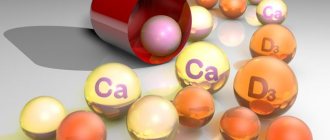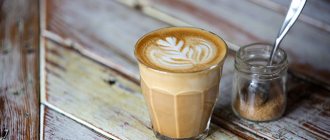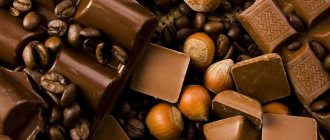Let's put the question bluntly: why even add milk to such a wonderful, world-favorite drink like coffee? It turns out there are reasons, and very convincing ones.
For example, one person uses milk to reduce the natural bitterness of a drink, another (concerned about health) neutralizes caffeine in this way, a third increases the calorie content (not everyone is struggling with excess weight!), a fourth dilutes the drink with milk to cool it faster, a fifth he simply wants variety, so he experiments with different additives.
They say you can't spoil porridge with oil. The same can be said about coffee and milk. These products have a long-standing friendship, which is reflected in various recipes.
We have already written in separate articles how coffee with cinnamon is prepared, how cappuccino differs from Turkish coffee. Today – all the details about coffee with milk.
Historical reference
In Europe, coffee was tried by the end of the 16th century, but only 100 years later the tradition of drinking it with milk began to take shape.
It is believed that she was born in France, where the new drink was called “café au lait”. But the latte, beloved by many, is its Italian relative.
The recipe, according to historians, was born in an unremarkable family during breakfast. Adults, as usual, drank black coffee, and for children, in order to introduce them to this drink (in those years there was no question whether children could drink coffee), hot milk was added to their cups. What we ended up with is what we know as “latte,” translated as “stained milk.”
Different nations have their own names: in Poland - “kawa biała” (“white coffee”), in the Netherlands - “koffie verkeerd” (“wrong coffee”), the British say “coffee with milk” (“coffee with milk”) , and in the American coffee chain Starbucks the name “misto” (from the Italian “mixed”, “mixture”) is in use today.
There are also different ways to obtain this drink. In Europe, it is prepared from traditional espresso by adding warmed milk. An Americano with milk is usually a drink prepared in a coffee machine using the drip method. Read more about what Americano coffee is in our article.
Benefits of coffee with milk
Coffee and milk are the same opposites as the heroes of Yankovsky and Bykov in the film “Two Comrades Served.” However, in both unions, as they say, “there is something.”
Judge for yourself: coffee invigorates us, and milk softens its activity - excitement increases gradually and persists for three hours.
And another example: coffee leaches calcium and vitamins from the body, and milk replenishes these losses. This is such a good compatibility.
Here is the positive effect coffee with milk has on a person:
- increases productivity, attentiveness;
- sharpens the perception of the surrounding world;
- unlike black coffee, it does not increase cholesterol levels as much;
- has a gentle effect on the body of people with high acidity and does not give such unpleasant consequences as heartburn;
- protects the esophagus from burns (and therefore from a number of diseases, including cancer), since it is not as hot as coffee without milk.
The above arguments suggest that a drink with added milk has its advantages compared to black coffee.
But there are also disadvantages (which, however, not all categories of people will perceive this way), this is the higher calorie content (energy value) of the product: a cup of Americano without milk contains 2 kcal, with milk (if there is 50 ml in a cup) the KBJU will be already 22 kcal when using milk with 1.5 percent fat content, 42 kcal when using milk with 6 percent fat content. The calorie content of all types of coffee with milk, with and without sugar, can be found here.
The BJU of this product (the ratio of proteins, fats and carbohydrates) is as follows: most are carbohydrates (45.9 percent), followed by proteins (29.3 percent) and fats (24.8 percent).
In diabetes, such an indicator as the glycemic index is very important. An index below 40 is considered low, and therefore acceptable for this category of people. In espresso with milk (without sugar) this figure is 18-23 units, for an Americano with milk - 28-33 (compare with a latte - from 75 to 90 units !).
By the way, instant coffee for diabetics is not as healthy as natural coffee, since its glycemic index (also taking into account added milk) is quite high - from 50 to 55 units.
By analyzing these numbers, each person can determine what is good for him and what is harmful, whether he should add milk to his cup of coffee or not.
Why is milk added to coffee?
The velvety blackness of coffee is diluted with a delicate milky taste for various reasons.
- Soften the natural bitterness of the taste of natural coffee.
- Reduce caffeine content.
- Increase caloric intake.
- Cool the finished coffee.
- Diversify taste sensations.
In every kitchen you can prepare such a drink by combining milk and coffee in any proportion. The recipe does not have a special name; it is named after the main ingredients - “coffee with milk” .
After all, all the recipes that we will talk about below are commercial products that require their own names and even legends. Homemade coffee with milk does not need branding, but it also has a little secret. If you want a truly delicious drink, use only heated milk. The taste and even color will be much better compared to coffee with cold milk added.
Types of milk-based coffee, what are they called?
You can brew coffee with milk in different ways. For example, without any water at all, but exclusively with milk, the drink will have a rich taste and a beautiful nutty color. This recipe is called “Warsaw-style coffee.”
But here are the options in which milk is used in different volumes and forms, as required by technology:
- cappuccino - equal parts milk and brewed coffee in this drink; what is the difference between a latte and a cappuccino, find out here;
- latte – milk takes up ¾ of the total volume (of all drinks this is the leader in the amount of milk used in it); We have the following material about recipes for making latte coffee at home;
- macchiato - an espresso-based drink, which is decorated with thin milk foam;
- mocha - hot chocolate and espresso in one cup with whipped milk; the most interesting mocha coffee recipes are collected here;
- brauner – natural coffee with milk in Austrian style;
- breve – espresso to which cream and milk are added (in equal quantities);
- cafe-au-le - a French recipe according to which the drink contains more milk than coffee;
- honey raf - a Russian espresso recipe, with the addition, in addition to frothed milk, of a small amount of liquid honey. You can find the most delicious raff coffee recipes at the link.
Which coffee and milk to choose
To get a tasty and aromatic drink, you need to choose freshly roasted coffee beans. The best option for this is Arabica beans. And those who prefer strength and bitterness in taste can add Arabica and Robusta in an amount not exceeding 20% of the total amount in the mixture. There are prepared grain mixtures on sale that take into account the required proportions.
Please note that Robusta contains more caffeine than Arabica. Some people prefer this type of coffee in the morning.
But Arabica in its pure form is considered the most optimal for making Turkish coffee with milk.
Experts point to 3 serious reasons not to choose Robusta or mixes containing it:
- The bitterness in Robusta intensifies even more during cooking in a Turk;
- The aroma of Robusta is not as intense and rich as that of Arabica, and in Turkish coffee is valued mainly for its taste and aroma;
- Coffee brewed in a Turkish coffee from robusta is too strong, which has a bad effect on the heart and blood vessels.
Arabica has many varieties with different tastes and aromas, so giving up Robusta does not lead to a loss of quality for the coffee drinker.
Types of drinks (photo)
1 of 7
Cooking recipes
When treating her family and guests, the hostess usually asks the question: “Do you want coffee with milk or without?”, as if there were only 2 options for this drink.
In fact, there are many more of them, and even at home you can experiment from time to time. For example, replacing cow's milk with goat's milk or even coconut milk.
With coconut milk
Strong black coffee is brewed in a Turk (a tablespoon of ground beans per 100 ml of water). Cold coconut milk (20 ml) is poured into a mug and freshly brewed coffee is added to it.
In a separate container, whisk 150 ml of regular milk and then pour it into a mug of coffee. This should be done carefully so that the lush foam remains on the surface of the drink in the form of a beautiful snow cap.
The result is a delicious, creamy coffee with a pleasant coconut aroma.
An interesting drink can be prepared by adding coconut oil rather than milk to coffee. Its nutritional value is so high that it relieves a person of hunger for a long time, while the drink remains low-calorie and can be used, for example, on a fasting day, maintaining a person’s strength and stimulating brain function.
With baked
The option with baked milk is for those who are afraid of gaining a couple of kg, but are unable to refuse something delicious. It is low in calories, has no sugar at all, but does have a little vanilla (1/3 teaspoon).
Here's how much of the remaining ingredients you will need: 125 ml of water, ground coffee - a teaspoon and a third of a glass of baked milk.
While the coffee is brewing, the milk should be heated in a separate cup, and then all the ingredients should be combined.
With condensed
The good thing about this recipe is that you can drink the coffee either hot or cold (in this case it is served in a tall glass, like a cocktail, with ice and a straw).
Black coffee is prepared according to a traditional recipe; 1 teaspoon of ground beans is enough for 100 ml of water.
Condensed milk is added to taste in a drink that has already cooled slightly: the fact is that some manufacturers curdle milk into coffee if it has just come off the heat, so it is better not to take risks, but to wait a minute or two.
In this article you will find recipes for making iced coffee: with ice and ice cream, chocolate syrup and candies, with yolk, banana, and a dietary option. Enjoy your coffee!
If you are interested in the difference between a coffee maker and a coffee machine, read our article.
With dry
This coffee will help you out at work or on a trip when you don’t have fresh milk and you’re not used to drinking black coffee on an empty stomach.
You will need a homemade preparation with milk powder (160 g), 40 g of cocoa powder and the same amount of instant coffee, 120 g of powdered sugar (pre-sifted using a sieve) and a small amount of cinnamon and vanilla.
All ingredients are mixed and poured into a glass jar - you can take the required amount from it and brew it with boiling water.
With soy
Soy milk as an addition to coffee is very popular today, especially for women who want to lose weight.
This kind of coffee (as well as with coconut and almond milk) is offered in Moscow by the Shokoladnitsa cafe chain. You can, of course, cook it in your home kitchen.
This recipe dispenses with water. Soy milk (150 ml) is poured into a Turk, sugar and cardamom are added, and ground coffee is poured in. Without stirring, place on the stove.
But when the drink starts to rise, they arm themselves with a spoon and stir. It is recommended to repeat this procedure twice. After this, the coffee can be served.
With almond
A spiced latte made with almond milk rather than regular milk is a wonderful holiday option that will surely pleasantly surprise your guests. Ingredients include hot red chili and tangerine.
The tangerine is peeled and divided into slices, the peel is not thrown away - it will also come in handy. Pour a third of a cup of almond milk into a saucepan, add a couple of cinnamon sticks, a little ground chili and vanilla, as well as tangerine slices along with zest.
Keep the saucepan on low heat for five minutes, without allowing its contents to boil. Then, after removing from the stove, strain.
The traditional way to brew coffee should be about 250 ml. Add strained almond milk flavored with unusual ingredients to it. The drink will be good with or without sugar.
WHAT ALL COFFEE LOVERS SHOULD KNOW: IF YOU ADD MILK TO ESPRESSO
It is difficult to imagine the modern coffee world without espresso. Although not every lover of a drink with milk knows about its importance. Many people believe that this applies only to fans of strong black coffee. But this is a gentle latte, a soft cappuccino or flat white for a pleasant conversation, and a fragrant macchiato in the morning.
The basis of such drinks that are familiar to us is espresso. Virtually the entire assortment in most coffee shops in European, American and post-Soviet countries relies on it. Let's take a closer look at those options that are prepared with milk. Let's find out what the fundamental difference is between them and which one to choose according to your mood.
The obvious option is macchiato . Let's start with it. In Italian, macchiato means stained. In this case, the speck is a spoonful of whipped milk against the background of nut cream, that is, foam. True, sometimes instead of 10-15 ml of speck, milk is added almost to the brim of the cup. It turns out, so to speak, a kind of variation on the theme of cappuccino. It’s also tasty and looks beautiful, but the drink is not the same.
But when they spread not milk, but whipped cream (sometimes sprinkled with grated chocolate), it turns out to be con panna (Italian with cream) or Viennese style . Before the widespread use of coffee machines, the coffee base of the Viennese drink did not play a special role. But starting from the second half of the twentieth century, it is rarely made with espresso.
By the way. It was thanks to Viennese coffee that the tradition of serving a glass of water also appeared. It all started at the end of the 19th century, of course, in coffee houses in Austria. The noble ladies who ordered this drink had a serious problem - what to do with a dirty spoon?
Putting it in cream on the edge of a saucer is blatantly inelegant, and the option of licking it first is generally beyond the bounds of etiquette. A glass of water intended for rinsing the spoon helped correct the situation.
Now let's move on to drinks that many do not associate with espresso. So, cappuccino . Its appearance is associated with the Capuchin monks. The monks generally gave us a lot of interesting things, invented personally or learned in distant unexplored countries. They showed their creativity with all sorts of goodies.
So in distant Japan, Jesuit missionaries began to fry shrimp, replacing the meat prohibited during Lent. This led to the emergence of such a Japanese dish as tempura. They also introduced the world to Paraguayan matte tea, at first even called the drink of the Jesuits.
But thanks to the Benedictines, we enjoy liqueurs, sparkling wine and Parmesan cheese. The situation with cheeses in general is such that there is hardly any known variety that is not of monastery origin. It was the monks who came up with the idea of smoking cheese, salting it, seasoning it with spices and noble mold.
However, let's return to the topic of our story. The monks loved to eat coffee with milk. Either they liked drinking this drink more, or they were masking the “devilish” black coffee, which was not encouraged by their superiors. Like many others who poured milk into coffee, they noticed the formation of a layer of pleasant-tasting foam. And they did not ignore this fact.
The story, retold many times over the centuries, has become a legend. The foam was obtained using various mechanical devices for whipping coffee with milk, and later hot milk. Then, at the end of the 19th century, a technological breakthrough took place. There were also inventors among the monks. One of them, Padre Carlo, came up with a way to froth milk with hot steam.
The idea was put into practice by a self-taught mechanic, Giuseppe, who lived near one of the monasteries north of Rome. His apparatus had two sections. In one of them, the water poured in was turned into steam by heating, which flowed through a tube into the second, where the milk actually frothed. Modern coffee machines with steam cappuccino makers use the same principle.
Rumors, and eventually the drink itself, first spread throughout Italy. Its milder taste has made it popular among coffee lovers in other countries. The name cappuccino comes from cappuccio - hood in Italian. According to the most popular and plausible version, it reflects the similarity of the pointed “cap” of milk foam with the hood of the Capuchin monks.
A classic cappuccino is usually described as a drink of three equal parts. That is, the ratio of espresso, heated milk and “hood” of foam should be 1:1:1. However, this rule is now outdated and has been replaced by the 1 to 4 option. Where one part is coffee, and four are milk and a layer of non-porous, thick, velvety foam approximately 1 cm thick. A standard portion is served in a special cappuccino cup with a capacity of 150-180 ml. Double is prepared on the basis of two espressos in a large cup - from 280 ml.
We also recommend: INSTANT COFFEE: ABOUT A SOLDIER’S LOVE, GOURMET CONTEMPT and INCREASED HARMFULNESS
Cappuccino is not drunk through a straw! Yes, it’s more convenient, especially when on the go. But the whole point of this drink is that when you tilt the cup or glass, the espresso mixes with the foam, becoming soft, tender and vanilla-sweet, and only then gets into your mouth.
And through the straw, the bitterness of espresso first hits the taste buds, and then comes the foam. In this case, you cannot do without sugar. But a properly prepared cappuccino: not scalding hot (up to 65 ° C) and with good milk, does not require sugar. The sweetness comes from the lactose contained in milk.
The cappuccino also has its own spoon. It is difficult to stir the sugar with a small coffee pot - it does not reach the bottom of the cup. Therefore, cappuccino is larger than coffee or tea, but smaller than a dessert spoon. Moreover, it can be not only made of stainless steel, but also wood, cupronickel, ceramic, glass, ivory, etc. However, in ordinary coffee shops they don’t bother too much and just serve a teaspoon.
In cappuccino, the combination of coffee and milk is harmonious. There is a balance between them without one predominant over the other. Those who prefer a milkier taste will like caffe latte or just latte .
It is prepared using one shot of espresso. In this case, unlike cappuccino, the milk hardly froths. The liquid is covered with foam about half a centimeter thick. The drink is served in a container with a volume of 210-240 ml. The proportions of coffee and milk in it are 1 to 6.
Caffe latte translates as coffee with milk. We usually shorten it to a latte. But in Italy you can well pay for such freedom. If you order just a latte (that is, milk), they will serve you a glass of it.
In Italian, latte is pronounced with the accent on the first vowel. So why do coffee gourmets argue about the correctness of the accent? The fact is that in the English-speaking powers the sound was transformed to suit the characteristics of their language, placing emphasis on the second vowel. And from them this option spread to other countries. That is, in fact, you can pronounce it in any way.
, latte is popular . This situation is similar to the case of Americano and long black, when the sequence of components during preparation affects the result. In the case of a latte macchiato, coffee is added to already poured and partially frothed milk, leaving a brown speck on the snow-white foam. The result is a beautiful layered drink, which is served in a tall clear glass goblet or tumbler.
For lovers of a more clearly visible coffee taste, there is a flat white. It originally appeared at the end of the last century in coffee shops either in Australia or New Zealand. In general, somewhere there. Some customers didn't like the pile of foam on their cappuccino. They believed that they were overpaying for air. Therefore, they demanded flat foam and a more coffee-like drink.
A flat white is prepared in a standard cappuccino portion based on not one, but two espressos. The ratio of coffee and milk is 1 to 3. The milk is whipped less than for cappuccino. It should be velvety, without bubbles and foam, which lies only on top in a thin (approximately 0.25 cm) even layer. It is usually served in a glass or cup with latte art.
Since this topic is truly vast, you probably have something to add, clarify or express your opinion. Don’t be shy and don’t delay – write in the comments to other readers.
Share information - don't leave your friends in the dark: Facebook
VK
Tumblr
StumbleUpon
Buffer
How to cook properly
The principle “milk is milk in Africa” is only suitable if you simply add it to a cup of coffee. More complex recipes place a number of demands on milk.
For cappuccino and latte it should be rich. Preferably natural; there should definitely be no powdered milk in its composition. And one more thing: the fresher the product, the more pleasant it tastes, so carefully study the labels in the store.
If you are going to froth milk, heat it to 70-75 degrees, but under no circumstances should you boil it: the boiled product will not froth.
You can froth milk in different ways:
- using a fork or whisk;
- in a regular jar with a tight lid (work with it like a bartender with a shaker so that the volume of milk doubles, and then open the lid and put the jar in the microwave for a while - the foam will become dense);
- in a French press (the container is filled no more than 1/3 and the piston is vigorously worked for 30-40 minutes, raising and lowering it);
- using a manual cappuccino maker;
- using an automatic cappuccino maker.
Cappuccino
The basis of cappuccino is espresso and milk. To prepare a cappuccino, it is heated and whipped into foam. The trick is to ensure that the milk contains both foam and liquid. Frothed milk is poured into a cup of hot espresso, forming a thick foam. In the process of adding milk, it is partially mixed with coffee, so the foam on the finished cappuccino has brownish stains around the edges.
Standard cappuccino proportions:
- 1/3 espresso
- 1/3 milk
- 1/3 whipped foam of dense, smooth consistency
Cappuccino is recognized as the most popular recipe in European and American coffee shops. Its volume can vary from 150 to 200 ml, depending on the establishment, but a mandatory serving rule is that the foam should rise slightly above the edge of the cup. The dense consistency allows the foam to retain its shape and not spill out over the top.
- What is the difference between latte and cappuccino: internal and external differences
Cappuccino is sometimes sprinkled with additives on top - cinnamon, chocolate, cocoa. It is drunk without stirring the foam, passing the coffee with milk through the silky foam structure with each sip. Connoisseurs of the drink do not add sugar to it in order to more fully experience the nutty and milky bouquet.
How can you replace milk?
An alternative to milk is required for those who are allergic to this product or want to cook something original. Coffee is not prepared except with yogurt and kefir, but in general there are many options.
Substitutes for cow's milk can be:
- soy, almond, rice, oat milk;
- marshmallow marshmallows (we wrote about recipes for coffee with marshmallows here);
- ice cream;
- airy cream from a can;
- milk liqueur.
Principles of the coffee diet
Coffee turns out to be so important for human health that doctors recommend it to their patients for chronic gastritis, hypertension, gallbladder disease, dumping syndrome (a complication caused by surgery to treat the stomach).
A concentrated drink is prohibited for such people, but a drink diluted with milk is necessary to maintain vitality, and therefore a faster recovery of the patient.
In some cases, the coffee “diet” is also beneficial for the liver, for heart failure and diabetes , and can be used as a diuretic. Even with pancreatitis, drinking very weak coffee with milk is allowed.
When losing weight, coffee is actively used; several special techniques have been developed.
Possible health hazards
Coffee with milk is contraindicated for people diagnosed with galactosemia, a disorder of carbohydrate metabolism. The drink has a laxative effect on their body: it can cause bloating, diarrhea, and flatulence.
Diarrhea, nausea, constipation, various rashes, pimples and other signs of allergies may appear in those whose bodies react painfully to either lactose or caffeine.
Contraindications also include:
- colitis;
- dysentery;
- stones in the kidneys;
- hereditary heart diseases.
The fact that pregnant women should limit their coffee consumption is discussed in a separate article.
Caution is also required for teenagers, since their nervous system is vulnerable, and coffee, even with milk, has a stimulating effect.
Possible negative consequences: inappropriate behavior, anxiety, nervous tics, bedwetting.
Find the benefits and harms of the drink, the correct proportions, as well as a recipe for coffee with cognac in this material.
Our publication will tell you about the health benefits and harms of cocoa powder.
Does coffee narrow or dilate blood vessels? Doctors' opinions are here: https://chay-i-kofe.com/kofe/kf-zdorove/kak-kofe-vliyaet-na-sosudy-suzhaet-ili-rasshiryaet/.
Reviews
Elizaveta N.: “You won’t believe it: I was on a coffee diet for 3 days and lost 3.5 kg. How long do you think it takes to digest coffee with milk? It turns out that it is not digested at all - the tannin and protein contained in milk form a kind of emulsion that is not digested in our stomachs. This principle, as I understand it, is what the diet is based on. In 3 days I drank so much coffee with milk, condensed milk, cloves and even honey that it literally made me sick. Besides, coffee in large quantities weakens me. But as soon as I remember the result, I’m ready for new tests. What can’t you do for your figure!”
Dmitry K.: “I don’t believe in the miraculous power of coffee for weight loss, or rather, I think that without some additional measures nothing will work. For example, I always drank and still drink a lot of coffee, but I started losing weight only after I stopped abusing my favorite whiskey, and my friends lured me to the gym.”
Larisa T.: “I’m afraid of gaining weight – this means cellulite and swelling. People get fat or lose weight not because they eat a lot or little, but because they eat incorrectly. The doctor advised me, for example, to switch from black coffee, which I drank in the morning, on an empty stomach, to coffee with milk. The taste, of course, is different from what I have become accustomed to over several years, but I feel light in my body and active. By the way, black coffee stains teeth, but if it is with milk, it does not. Also a plus."
Latte
To prepare it, use a shot of espresso and a lot of milk. Foam is also present in latte, but in smaller quantities than in cappuccino. It has a different consistency - loose, moist, with a lot of large bubbles.
Standard latte proportions:
- 1/5 espresso
- 3/5 hot milk
- 1/5 milk froth
It is more correct to call a latte a cocktail. The coffee component in it is minimal. In addition, lattes often add large amounts of sugar and toppings, which makes them overly sweet, according to coffee connoisseurs.
Latte has a solid volume, which has shown an upward trend in recent years. Today you won’t surprise anyone with a glass of 400 ml drink.
This version of coffee with milk provides great opportunities for creativity. Its taste qualities are constantly diversified by adding various syrups and fruit water, and painting on its surface has become a separate direction and is called “latte art.” World championships are held on it.
The coffee recipe with a lot of milk has another option - latte macchiato. If a regular latte is stirred to form a homogeneous liquid with a top layer of foam, then a macchiato is poured in layers. Coffee, milk and foam are clearly separated in the glass. Unlike a regular latte macchiato, latte macchiato is not stirred, but sugar and toppings are added to the drink during its preparation, before serving.










